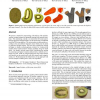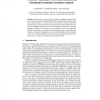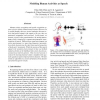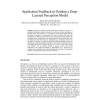650 search results - page 93 / 130 » Modeling spatial patterns of shapes |
TOG
2008
13 years 7 months ago
2008
We present a method for representing solid objects with spatiallyvarying oriented textures by repeatedly pasting solid texture exemplars. The underlying concept is to extend the 2...
AIME
2007
Springer
14 years 1 months ago
2007
Springer
We present a novel method for predictive modeling of human brain states from functional neuroimaging (fMRI) data. Extending the traditional canonical correlation analysis of discre...
CVPR
2011
IEEE
13 years 3 months ago
2011
IEEE
Human activity recognition and speech recognition appear to be two loosely related research areas. However, on a careful thought, there are several analogies between activity and ...
BICA
2010
13 years 2 months ago
2010
Deep-layer machine learning architectures continue to emerge as a promising biologically-inspired framework for achieving scalable perception in artificial agents. State inference ...
COMSNETS
2012
12 years 3 months ago
2012
—Patterns of human encounters, which are difficult to observe directly, are fundamental to the propagation of mobile malware aimed at infecting devices in spatial proximity. We ...




